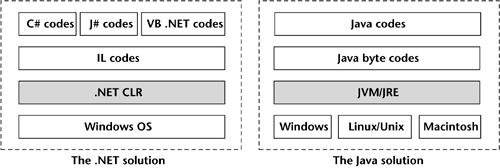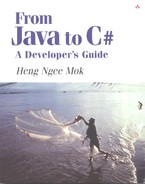1.6. Competing in parallel with Java technologies
For developers, the picture of .NET represents one that competes directly with Java and J2EE technologies. Although most of the computer science concepts behind these two paradigms are similar, in most cases they represent two completely different ways of doing the same thing. [22]
[22] I have read several white papers on the Internet attempting to compare J2EE with .NET. Unfortunately, no matter how unbiased the parties are trying to be towards the two technologies, a trained eye can often tell the prejudices 'encoded' between the lines. I have yet to see a really neutral and fair comparison released by an impartial third party such as an academic institution or standards body. If you try to use such comparisons, take them with a pinch of salt. It will be difficult for someone familiar with only one of the technologies to fully appreciate the facts and separate them from the red herrings.
| Java/J2EE | .NET | |
|---|---|---|
| General | ||
| Language | Java | VB .NET, C#, C++, J# and many other third-party languages |
| Platforms | Windows, Solaris/Unix/Linux, Macintosh | Windows only (possibly Linux and FreeBSD in the near future) |
| Web/application server | A large variety to choose from: Tomcat (servlet/JSP), JBoss (EJB), Weblogic Application Server, Oracle Application Server, Borland Enteprise Server, Silverstream Server, HP Bluestone, JRun Application Server, IBM Websphere, Sun ONE Server (formerly iPlanet Application Server), etc. | Microsoft IIS, Windows 2000, Windows .NET Server |
| IDE/tools | A large variety to choose from: Forte, JBuilder, Netbeans, JCreator, Kawa, Visual Café, Visual Age, etc. | Microsoft VS .NET |
| Technologies | ||
| Presentation tier technology | Servlets and JSP | ASP .NET |
| Business tier technology | EJB | .NET managed components |
| Technology for cell phones and PDAs | J2ME | .NET compact framework |
| Significant distribution protocols | Java RMI (RMI-IIOP or RMI-JRMP), CORBA IIOP (using Java IDL), SOAP (for web services) | DCOM, SOAP (for web services) |
| API classes | ||
| Database access API | JDBC | ADO .NET |
| Messaging API | JMS | MSMQ |
| Web services API | Java Web Service Developer's Pack (includes JAXP) | Part of the .NET BCL |
Table 1.3 shows the parallelism and directly competing products/methodologies between .NET and J2EE. A detailed discussion is, unfortunately, beyond the scope of this book. Figure 1.3 shows the comparison in block diagram form. Finally, Figure 1.4 gives a schematic view of the parallelism.
Figure 1.3. Comparing .NET and Java.

Figure 1.4. A simplified schematic showing parallel comparison of how .NET and Java work – .NET focuses on language independence, while Java's game is platform independence.

